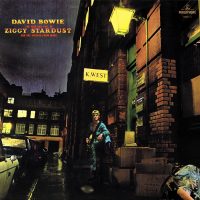 Recorded: 8, 10, 11, 12, 15 November 1971; January-February 1972
Recorded: 8, 10, 11, 12, 15 November 1971; January-February 1972
Producers: David Bowie, Ken Scott
Released: 16 June 1972
Personnel
David Bowie: vocals, guitar, saxophone, recorder
Mick Ronson: guitar, piano, Mellotron, ARP synthesizer, vocals
Trevor Bolder: bass guitar
Mick ‘Woody’ Woodmansey: drums, percussion
Rick Wakeman: harpsichord
Dana Gillespie: backing vocals
Unknown: orchestral musicians
Tracklisting
Contents
- ‘Five Years’
- ‘Soul Love’
- ‘Moonage Daydream’
- ‘Starman’
- ‘It Ain’t Easy’
- ‘Lady Stardust’
- ‘Star’
- ‘Hang On To Yourself’
- ‘Ziggy Stardust’
- ‘Suffragette City’
- ‘Rock ‘N’ Roll Suicide’
The album with which David Bowie became a fully-fledged star, The Rise And Fall Of Ziggy Stardust And The Spiders From Mars was a loose concept album about a bisexual, androgynous rocker who became a conduit for alien beings in a dystopian alternate reality.
I think I did play outside the boundaries of what is considered area of rock ‘n’ roll. Some of it, just pure petulance, some of it was arrogance, some of it was unwitting, but, inevitably, I kept moving ahead.Ziggy, particularly, was created out of a certain arrogance. But, remember, at that time I was young and I was full of life, and that seemed like a very positive artistic statement. I thought that was a beautiful piece of art, I really did. I thought that was a grand kitsch painting. The whole guy.
Melody Maker, 29 October 1977
The Ziggy Stardust concept
David Bowie’s fifth album was his first to be promoted as a concept album. He had previously toyed with loose thematic links, such as the meditations on madness in The Man Who Sold The World, or the pen portraits on the second half of Hunky Dory, but The Rise And Fall Of Ziggy Stardust And The Spiders From Mars was perhaps his most focused offering to date.
At its heart, the album was a reflection on the nature of celebrity and artifice. Speaking in 1976 of its follow-up, Aladdin Sane, Bowie remarked: “I packaged a totally credible plastic rock star — much better than any sort of Monkees fabrication. My plastic rocker was much more plastic than anybody’s.”
Bowie drew upon a variety of non-musical influences and sources for the concept, from pop artist Andy Warhol to films such as Metropolis, Pork, and Stanley Kubrick’s 2001: A Space Odyssey and A Clockwork Orange. He also created powerful visual imagery, invoking Japanese kabuki theatre, mime, androgynous hair and make-up, and glam rock-era clothes including platform boots, jumpsuits, and an iconic red mullet haircut.
Bowie had long yearned for fame and fortune, and had tried on a variety of guises with limited success. This time he laid out his masterplan in plain sight, and unusually invited his audience to become co-conspirators in the deceit. This assisted the notion of Bowie as a ringleader, and his followers as members of a secret, exclusive society – even long after he became a worldwide phenomenon.
This sense of complicity was laid bare on the song ‘Star’, in which Bowie sang about making “a transformation as a rock and roll star”:
So inviting, so enticing to play the part
I could play the wild mutation
As a rock and roll starI could do with the money
I’m so wiped out with things as they are
I’d send my photograph to my honey
And I’d come on like a regular superstar
Upon the album’s release, Bowie’s manager Tony Defries encouraged the singer to act like a star in order to become one. Even in countries where he was less well known, he was accompanied by bodyguards, had assistants to open doors for him, strictly controlled media access, and was chauffeured everywhere by limousine.
“Tony Defries had this idea that if we just told the world that I was super huge, and then treated me as though I were, then something might happen,” Bowie later said. “As we know, Defries was right.”

I love this website. What great and well-researched info.
The song Ziggy Stardust also invites his audience to become co-conspirators in the deceit he’s playing a character.
When you read the lyrics it’s written by someone who seems like an outsider telling the story. The person tells you about Ziggy, the spiders and some related characters almost as a fan talking about a past legend and his fame. Then the last line
“when the kids had killed the man
I had to break up the band”
suggests the person telling the story is not a fan but someone with the power to destroy the messiah. Bowie himself tells you he’s going to kill the character when the kids take it too far.
It is amazing to admit the myth in plain sight and not many noticed it at the time.